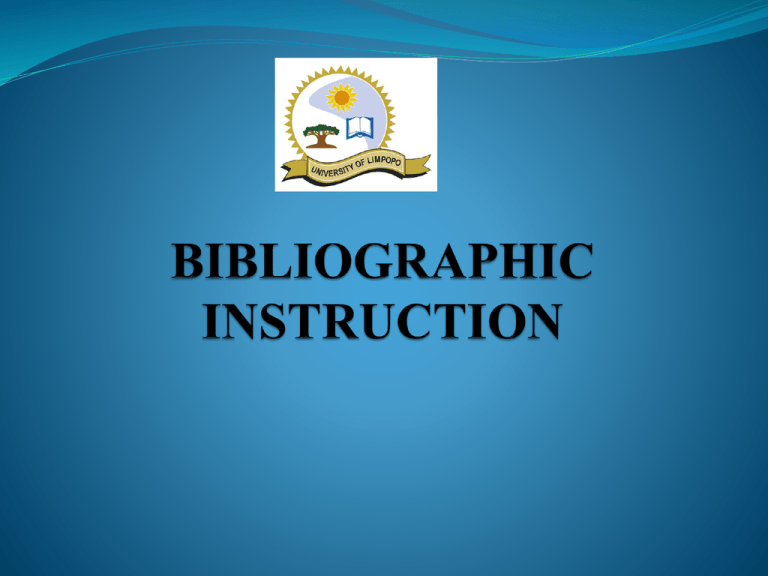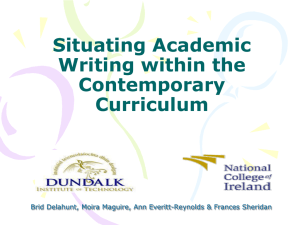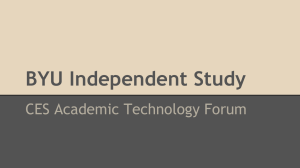BIBLIOGRAPHIC INSTRUCTION
advertisement

Introduction Bibliographic instruction is training that is offered to students to achieve the following objectives: To train library users to be independent in searching for information. unveils the information world to students. Empowers students with self confidence to become life long leaners. Strives to meet the information literacy competency standards for higher education. Enhances the quality of students work ( improve students’ research ability) Library Services Client Services Information Services Main reserve Government Documents Circulation Desk Africana Reserve Inter- Library Loan Law Reserve Subjects Librarians Information sources in the library Books and eBooks CD Roms Audio visuals Video Cassettes Periodicals(journals, Subscribed Databases newspapers, and magazines) Print and Online Reference Sources Internet Library catalogue The library catalogue is a register of all bibliographic items found in a library or group of libraries. A bibliographic item can be any information entity (e.g., books and audio visuals, etc.) that is considered library material. The library catalogue enables the users to view the collection from Turfloop, Medunsa, Mankweng and Polokwane libraries. Users are able to select or limit their search to a preferred library. The Library catalogue can be accesses in two ways URL Access Click on ‘internet explorer’ Type in this address http://196.21.109.8:208 2 or click here on the address bar Press enter The library catalogue screen will appear University Website Access Click on ‘internet explorer’ Type in this address http://www.ul.ac.za in the address bar Press enter Click on Library Click Library Catalogue The library catalogue screen will appear Access points which can be used to search the catalogue Keyword (e.g. library management) Title (e.g. Romeo and Juliet) Author (e.g. Shakespeare, William) Subject (e.g. Global warming) Depending on your search terms you can use any of the above access points NB. Example of doing title search Type the title of the book in the search box as indicated in the following slide Where book is located Address of the book on the shelf Availability of the book Search results The previous slide shows the copy status of the record, which consists of the location, call no and the status of the book. Location - the place where the book is located e.g. Main reserve Africana Turfloop main open stack Law reserve Government document Turfloop management open stack Call number – a group of numbers put together to tell you where on the library shelves to find your book ( address of the book on the shelves). Call number comprises of numbers and alphabets. E.g. 822.1 SHA 822.1 stands for class number SHA stands for the first three letters of the author’s surname Search results cont. In some cases the call numbers will start with the following prefix: Status • The status indicates the availability of the resources searches. A- Africana e.g. A 828.903 ACH AV-Audio Visual e.g. AV 342.066068 MAI G- Government documents e.g. G 553.7 INT R- Reference e.g. R 610.3 DOR T-Thesis e.g. T 344.0523 CHA • It can either be the following• • • • • • • Due date Available Bindery On order Ask for assistance Withdrawn Missing Other functions on the catalogue Added functions for library users Electronic databases It is a computer-based collection or listing of information, usually organized with searchable elements or fields. The most common type of library database consists of records describing articles in journals or newspapers. A database could be as simple as an alphabetical arrangement of names in an address book or as complex as a database that provides information in a combination of formats. Some databases are available to users freely without a subscription, e.g. JSTOR, SAFLII etc. Types of databases Bibliographic databases: Offer citations of articles in magazines, journals, and newspapers. Some may also contain Abstracts, e.g. ISAP on Sabinet, Science Citation Index etc. Full text Databases: contain full text of articles in different formats such as PDF or HTML format, e.g. Sciencedirect, SA e-publications etc. Numeric databases: Provide numeric data such as statistics, survey results, census information, e.g. Stats SA. NB. The library subscribes to a number of online databases which can be accessed through internet using Username & Password. Click here for list of databases Electronic databases can be accessed in two ways URL Access example: University Website example: Click on ‘internet explorer’ Type in this address Click on ‘internet explorer’ Type in this address http://www.ul.ac.za in the address bar Press enter Click on library Click on e-resources and click on databases to select the database of http://search.ebscohost.com in the address bar Press enter The screen on the next slide will appear. your choice. E.g. http://search.ebscohost.com The screen on the next slide will appear. Search all databases simultaneously Select and Search from sub databases Ebscohost Web Click on Ebscohost web to be able to view and select your choice of sub databases. • • • The above screen shows the sub databases. You select the preferred sub database/s as shown above. Click “continue” button and the search screen on the next slide will appear . Search tips Identify keywords in a topic. Limit the search by language, publication date or place Use Boolean logic operators: AND, OR, NOT Always use related words and synonyms Click here for search tips Enter search terms Search results Refine or limiting your results You can refine or limit your results by using the following options: Full text Date Scholarly peer reviewed journal Relevance Select one option depending on your needs Search results Click on the magnifying icon or the title to read the abstract Click on pdf to open the full text document Print, email and save the document Copyright Copyright is a law that gives ownership over the works one has created. The ownership that copyright law grants comes with the following exclusive rights for the owner : • The right to reproduce the work • to prepare derivative works • to distribute copies • to perform the work • and to display the work publicly Works protected by copyright Copyright protects the form of expression of a creator against copying which include the following: Literary Works Musical Works Artistic Works Cinematograph Films Broadcasts Programme-carrying signals Sound Recordings Published editions Computer Programs Works not protected by copyright Some works, including the following, are not eligible for copyright protection: Short phrases Single words Works not in a tangible format (for example, ideas) Names and titles Slogans Commonly-known facts that are not the subject of original authorship Students are prohibited to: Make multiple copies for commercial purposes Scan, adapt, translate or convert information into different formats without permission Place copyright-protected works onto any web-page without prior permission Photocopy more than 10% of a book or journal Reproduce sheet music, videos, tapes, CDs, DVDs, films, sound recordings, etc. without prior permission. What is Plagiarism Plagiarism is the act of using another person's writing, conversation, song, or even idea and passing it off as your own without crediting the original owner. • This includes information from web pages, books, songs, television shows, email messages, interviews, articles, artworks or any other medium. Types of Plagiarism Verbatim Copying: Material is copied word for word with no acknowledgement of the sources of the text Straight Plagiarism: Changes capitalization or sentence structure. A word may be added or deleted Patch Writing: Copying a few sentences from different sources Collusion: Using another student’s work with their permission Purloining: Taking work from another student without their permission Ghost Writing: Work is written by someone else and presented as the student’s own. Continuation Types of Plagiarism Ghost Writing: Work is written by someone else and presented as the student’s own. Recycling: Presenting your own work to be assessed more than once Make-up referencing: False details about the source or the Author For more information about Plagiarism click here http://www.plagiarism.org. Turnitin Anti-plagiarism Software Is a web-based plagiarism detection software owned by Turnitin.com. Turnitin is a anti-plagiarism software which is used to identify matches in uploaded documents against other sources. Turnitin has a large database consisting of millions of web pages, books, journals, papers and previously submitted documents. It is used by Universities to help identify potential plagiarism in studentsubmitted work. Turnitin can be used to teach students how to properly acknowledge quotations How does Turnitin work Students can: • Submit assignment or research paper to turnitin as a draft • See original report • Correct plagiarism errors and submit assignment or research report Click here to access Turnitin REFERENCING TECHNIQUES Referencing is precisely describing, listing and referring to the sources at the appropriate places in the text. A reference list is placed at the end of an assignment. It includes all the references that you have cited in the text of your assignment. It is arranged alphabetically by author. If referencing in not done correctly, it may give the impression that you are trying to pass off the work of another as your own and you may be accused of committing plagiarism which is a serious offence. The format of a reference list depends on the type of reference used. Always use the correct format for each reference used. The purposes of acknowledging sources are: • To allow other people (researchers, lecturers, colleagues) reading your work to be able to access the original source and make a follow – up reading • To serve as evidence on which your statements, arguments, assertions, ideas, conclusions, and information are based. • To avoid plagiarism It is therefore important to acknowledge sources correctly and accurately. Types of Referencing Styles The UL prefers the Harvard and Vancouver referencing styles For Harvard referencing style click here For Vancouver referencing style click here NB: Check with your lecturer which referencing style you should use. IN-TEXT REFERENCING/CITING When you cite (identify) references in the text of your report or essay using the Harvard Style, you should include the following pieces of information. • Surname(s) of the author or authors • Year of publication • Pages numbers if appropriate The sentence starts with the surname of the author followed by the date and page reference in round brackets. Example of how to cite




